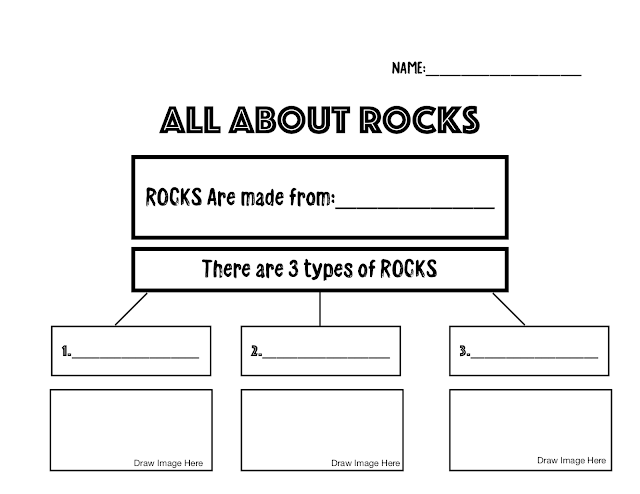Here is a great learning plan to introduce children to the three types of rocks. (It also accompanies any rock cycle lessons plans quite nicely). In an inclusive learning environment, I like to present the material to the kiddos and give them the opportunity to participate. I always give plenty of time and space. I believe it helps them learn, explore, and question things in their own way, which leads to greater retention and more fun!

ALL ABOUT ROCKS LEARNING PLAN
Vocabulary/Reading
- Rock Videos [discuss the three types of rocks]
- (Igneous, Sedimentary, Metamorphic)
- Rock Field Guides
Observation/Discovery
- Explore Rocks
- Discuss Observations
- Identify Rocks
Mathematics
Science
- Starburst Science Experiment
Art/Movement
- Hopscotch with Rocks
- Rock Painting
- Rock Mandalas
ALL ABOUT ROCKS LEARNING PLAN
Vocabulary/Reading
First we watched rock videos to get them introduced to the terms and concepts. I always watch the videos the night before to get caught up and look for any conflicting info (things change in science!)
Here are the ones that worked best for my kids, but there are a ton online, and all kids have different styles:
The "Learning Principles" are below:
Rocks are made of minerals
There are three types of rocks: Igneous, Sedimentary, Metamorphic
Igneous: heated and cooled into a new rock
Sedimentary: made from pieces (sediments) layered upon each other
Metamorphic: rocks "changed" from heat and pressure
Below is a free worksheet that is great to introduce after the videos:
Next I introduce rocks and the field guides (there are usually a ton at the local library)...
Observation and Discovery
We used this time to explore rocks, classify them, and verify in the rock field guides. You can find examples of types of rocks to provide here:
- Igneous Rock Examples: basalt, dacite, obsidian, pumice, rhyolite, scoria, and tuff
- Sedimentary Rock Examples: sandstone, limestone, and shale
- Metamorphic Rock Examples: gneiss, slate, marble, schist, and quartzite
You can order rock sets, or go to a local rock shop to find some examples -- you can even go on a nature walk and try to classify your own rocks from your neighborhood! (Below we used: amber, rhyolite, shale, quartz, and conglomerate)
Mathematics
The kiddos had so much fun making multiplication equations with rocks. We used a large pile of small rocks, and separated them into piles to give a visual to the equation. My five year old practiced 2, 5, and 10. While my seven year old worked equations up to 12s.
Next (in true homeschool style) they invented their own math games with the rocks and index cards and got even more counting practice using their own imaginations -- it seems to work this way a lot when I let them get creative and give them plenty of space and time to explore.
Science Experiment
For this project we used Starburst as the particle to make our rocks.
- Cut the colorful Starbursts into little cubes
- Layer them on top of each other to make "Sedimentary" rocks
- Smash them (using heat and pressure) to make "Metamorphic" rocks
- Microwave them to use heat to fuse them together to make "Igneous" rocks
Here are some images to use as a visual (this is a fairly popular experiment and you can find videos on youtube if you need more guidance!)
Art and Get Moving
There are so many activities to do with rocks, and I wanted to add of extra ideas to help any homeschool families that might be stumped for activities this week:
- Hopscotch
- Nature walk collecting/identifying rocks
- Rock painting
- Rock mandalas
Have fun -- and keep learning!





























